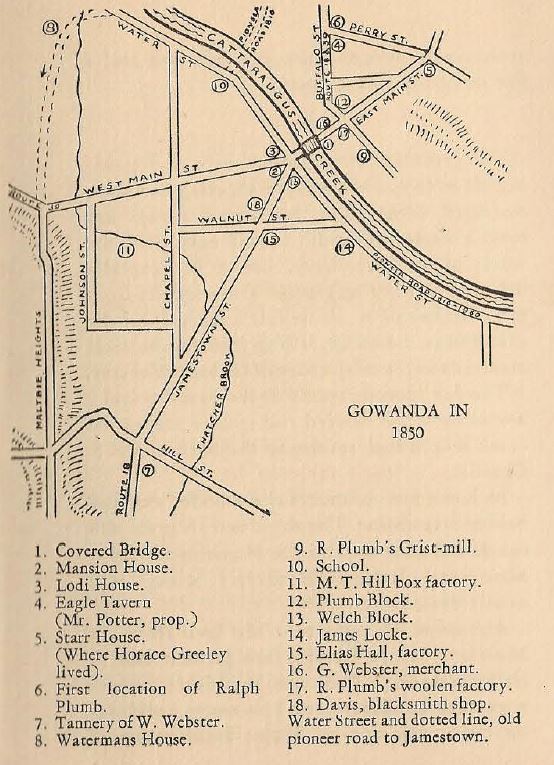
|
Two Gowanda youths, Franklin Peacock and . Ebenezer Henry, were horribly injured. The injuries were so severe to Franklin Peacock that he died. Porter Welch opened a new road through the Dayton Valley ·to Dayton Summit. A stage coach made daily trips from Gowanda to the railroad station at Dayton for the convenience of passengers. Up until the coming of the railroad, the locale of the village of Cattaraugus was a dense forest. In 1851, Joseph Plumb, brother of Ralph Plumb, moved to New Albion in Cattaraugus County and bought a large tract of land. This was subsequently the site of Cattaraugus village which developed with the coming of the railroad. Joseph Plumb sold lots to all the villagers who would buy them but he insisted on inserting a clause in all his deeds to the effect that if liquor, wine or beer were ever sold on the property as a . beverage the land would revert to the heirs of the Joseph Plumb estate-a provision that is in force to this day. Chester Howe was elected Judge of Cattaraugus County in 1851. In 1852 Ralph Plumb & Son completed a new business block |
|
Page Thirty-nine |
|
|
at East Main and Buffalo Street. J. G. Van Ostrand was the architect and thanks to its sturdy construction it is still standing and in use. Seeley Blackney bought the Mansion House. 1852 was also a memorable year for Gowanda as the tanning industry at Hidi began at that time. Albert Gaensslen moved to Gowanda that year and converted the old woolen mill at Hidi into an upper leather factory. The two outstanding events of 1855 were the visit of P. T. Barnum's "Museum and Menagerie'' to Gowanda on May 20 and the burning of the Depot at Dayton Summit on September 1. The station burned to the ground at a loss of $6,000. The last general training, under the old compulsory law, held by the Gowanda (then Lodi) militia, occurred in 1846 and at that time the company disbanded. In May, 1853, orders were issued, authorizing the organization of company A, 64th Regiment N. Y. S. Militia, of Gowanda. The company was indebted for its organization to Col. Thomas J. Parker, Captain Levi W. Strope, Major Green and others. The community was |
enthusiastic over the new organization and a fine company was formed. ★
The great fire, that came so near to destroying all of Gowanda, started shortly after noon on April 20th, 1856. Its origin always has been a matter of doubt. It may have been the work of an incendiary, but it is generally believed to have originated from sparks from the chimney of A. R. Sellew' s farnace on the east side of the creek, falling into combustible materials in the tub factory of Gideon Webster. The fire spread rapidly to the foundry and a northeast wind carried the sparks across the creek where they set fire to the barn of Dr. S. C. Ellis. In just a few moments the wooden-covered bridge was ablaze. The draft was so great that the flames shot over to the Mansion House at Main and Jamestown Streets which was totally destroyed. Almost at the same time the Lodi House at Main and Water Streets, ( the present site of Hiller's store), was on fire. By this time it was a general conflagration. The many buildings on the creek side of Water Street were all |
|
Page forty |
|
|
burned. Below the bridge, the grocery of L. N. Gardner and J. P. Roller's meat market were burned. Other buildings reached by the fire were: H. N. Hooker's store; the Lodi House barn; William Woodbury's law office; the Mansion House barn; two stores, including the Post Office, dwelling house and barn property of D. N. Brown, Postmaster; John Pierce's house; E Drake's shoe shop; house owned by Porter Welch and T. Howard's bakery, all lying beween Main and Jamestown Streets. E. S. & T. S. Griswold's grocery; Hiram Palmer's Harness shop; John P. Roller's meat market; N. Blackney's grocery; T. J. Parker's clothing store; Porter Welch's dry-goods store; Odd Fellow's Hall; Zimri Warner's clothing store; Gideon Webster's building; A. L. Chaffee' s Dry-goods store; Sellew's Block; the millinery store of Miss Eliza G. Agard, the "Chronicle'' office; Charles Rollinson' s furniture store; M. F. Crandall's gun shop; L. Orr's grocery; H.K. Dawson's wagon shop; William Dauber's blacksmith shop; dwelling of H. M. Morgan. On the east side, A. R. Sellew's furnace; Gideon Webster's pail factory; Ashel Camp's |
woolen factory; the Webster block; E. W. Henry's store; the old grist-mill and saw-mill of Ralph Plumb; the veneering shop of McMillen and Bugbee, and the Wooden Bridge. The fire raged most of the afternoon. By that time every business place on the Erie side was destroyed (except the Plumb Block), the old woolcarding mill and saw and flour-mill. On the Cattaraugus side, on Main Street, all buildings on the north side to the old brick office (about where Gulley's store stands today). On the south side of Main Street to Delia Waterman's house (the home of the late Mrs. J. Matthews) and all buildings on Jamestown Street, to the Davis blacksmith shop ( this old shop still stands). On the east side of Jamestown Street all b·uildings were burned to the old Stebbins house (now owned by F. Bruce estate); on Water Street up stream, to Hiram Palmer's house (present location of Frontier Publishing Co.), down Water Street as far as the old Fields house (54 Water Street). Thus the fire was a major catastrophe. But the townspeople resolutely faced the destruction, determined to rebuild their commercial community and carry on the business activities. |
|
Page forty-one |
|